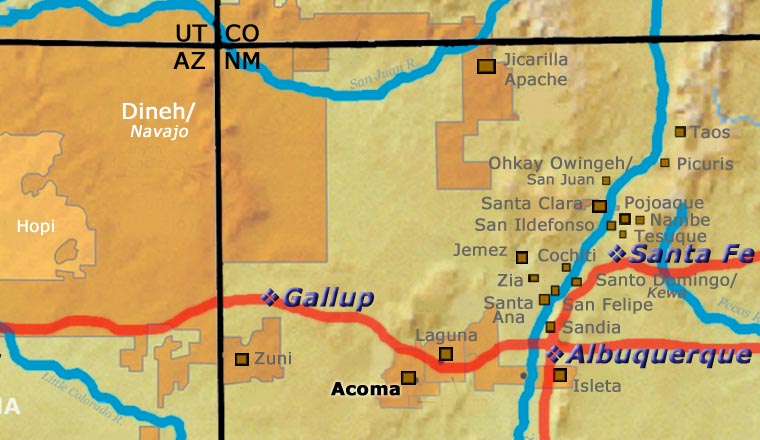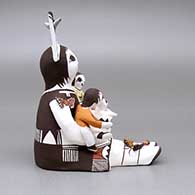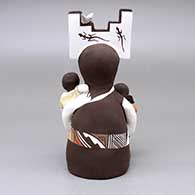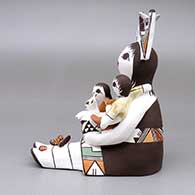
Judy Lewis
Acoma
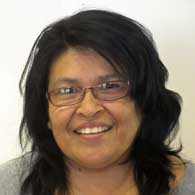
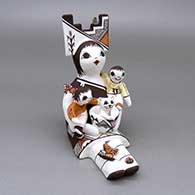
Judy Lewis was born in 1966 into the Pueblo of Acoma. Taught mostly by her older sister, Marilyn Ray, Judy was inspired to continue potting in the family tradition when she was 20.
She is a member of one of the two non-related Lewis families at Acoma Pueblo: the Lucy Lewis family is the more well known but the family of Katherine Lewis (Marilyn Ray, Rebecca Lucario, Carolyn Concho, Diane Lewis and Judy Lewis) are known for some of the most innovative pottery being produced at Acoma. Each member of the family has carved out their own particular niche: Judy fashions storyteller, corn maiden, and friendship bowl figures with detailed facial expressions and joyous dispositions accented with butterflies, bluebirds, cats, dogs and ladybugs. Her work is the expression of an artist who obviously truly loves what she does.
Judy's hand pinched and coiled contemporary shapes are accented with finely executed traditional designs and natural pigments. The natural clay of the Acoma area is very white, which gives her pieces a built-in radiance that is matched by her figures' sweet smiles.
Over the years Judy has earned numerous awards at the Santa Fe Indian Market and the Eight Northern Indian Pueblos Arts & Crafts Show. She signs her work: "Judy Lewis, Acoma, N.M."
100 West San Francisco Street, Santa Fe, New Mexico 87501
(505) 986-1234 - www.andreafisherpottery.com - All Rights Reserved

Acoma Pueblo
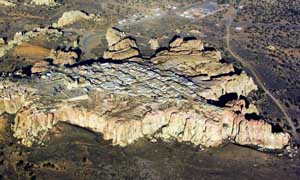
Sky City
According to Acoma oral history, the sacred twins led their ancestors to "Ako," a magical mesa composed mostly of white rock, and instructed those ancestors to make that mesa their home. Acoma Pueblo is called "Sky City" because of its position atop the mesa. Acoma is located about 60 miles west of Albuquerque.
Acoma, Old Oraibi (at Hopi) and Taos all lay claim to being the oldest continuously inhabited community in the U.S. Those competing claims are hard to settle as each village can point to archaeological remnants close by to substantiate each village's claim. While the people of Acoma have an oral tradition that says they've been living in the same area for more than 2,000 years, archaeologists feel more that the present pueblo was established near the end of the major migrations of the 1300s. The location is essentially on the boundary between the Mimbres-Mogollon and Ancestral Puebloan cultures. Each of those cultures has had an impact on the styles and designs of Acoma pottery, especially since modern potters have been getting the inspiration for many of their designs from ancient pot shards they have found while walking on pueblo lands.
Francisco Vasquez de Coronado ascended the cliff to visit Acoma in 1540. He afterward wrote that he "repented having gone up to the place." But the Spanish came back later and kept coming back. In 1598 relations between the Spanish and the Acomas took a really bad turn with the arrival of Don Juan de Oñaté and the soldiers, settlers and Franciscan monks that accompanied him. After ascending to the mesa top, Oñaté decided to force the Acomas to swear loyalty to the King of Spain and to the Pope. When the Acomas realized what the Spanish meant by that, a group of Acoma warriors attacked a group of Spanish soldiers and killed 11 of them, including one of Oñaté's nephews. Don Juan de Oñaté retaliated by attacking the pueblo, burning most of it and killing more than 600 people. Another 500 people were imprisoned by the Spanish, males between the ages of 12 and 25 were sold into slavery and 24 men over the age of 25 had their right foot amputated. Many of the women over the age of 12 were also forced into slavery and were eventually parceled out among Catholic convents in Mexico City. Two Hopi men were also captured at Acoma and, after having one hand cut off, they were released and sent home to spread the word about Spain's resolve to subjugate the inhabitants of Nuevo Mexico.
When word of the massacre and the punishments meted out got back to King Philip in Spain, he banished Don Juan de Oñaté from Nuevo Mexico. Some Acomas had escaped that fateful Spanish attack and returned to the mesa top in 1599 to begin rebuilding. In 1620 a Royal Decree was issued which established civil offices in each pueblo and Acoma had its first governor appointed. By 1680, the situation between the pueblos and the Spanish had deteriorated again to the point where the Acomas were extremely willing participants in the 1680 Pueblo Revolt.
After the successful Pueblo Revolt the Spanish retreated back to Mexico. Refugees from other pueblos began to arrive at Acoma, fearing an eventual Spanish return and reprisals. That strained the resources of Acoma until the Spanish actually did return. The residents of the pueblo had to make a hard decision. Many of the refugees chose to try a peaceful solution: they quickly relocated to the ancient Laguna area and made peace with the Spanish as soon as they appeared in the region.
Over the next 200 years, Acoma suffered from breakouts of smallpox and other European diseases to which they had no immunity. At first they sided with the Spanish against nomadic raiders from the Ute, Apache and Comanche tribes. Then New Mexico changed hands, the railroads arrived and Acoma became dependent on goods brought in from the outside world.
For many years the villagers had been content on the mesa top. Now most live in villages on the valley floor where water, electricity and other necessities are easily available. While a few families still make their permanent home on the mesa top, the old pueblo is used almost exclusively for ceremonies and celebrations these days.
It's the dense, slate-like clay, that allows Acoma pottery to be thin, lightweight and durable. After they form a pot, they paint it with a white slip. Once dry, black and red design motifs are added using mineral and plant derived paints. Fine lines, geometrics, parrots and old Mimbres designs are common motifs. The traditional paintbrush is chewed from the yucca leaf. Historically, Acoma was known for large, thin-walled "ollas," jars used for storing food and water. With the arrival of the railroad and tourists in the 1880s, Acoma potters adapted the size, shapes and styles of their pots in order to appeal to the new buyers.
Acoma potters felt it was an inappropriate display of ego to sign a pot up into the mid-1960s. Then Lucy Lewis, Jessie Garcia and Marie Z. Chino started signing their pots. The 1960s is also a time when the primary Acoma white clay vein passed through a layer of widely distributed impurities, impurities that passed through the clay filtering process and showed up only during and after the firing. The problem was so bad it affected virtually every Acoma potter and every pot they made. Thankfully, by the late 1960s they had dug through that layer of clay and into a deeper layer that didn't have the problem.
100 West San Francisco Street, Santa Fe, New Mexico 87501
(505) 986-1234 - www.andreafisherpottery.com - All Rights Reserved

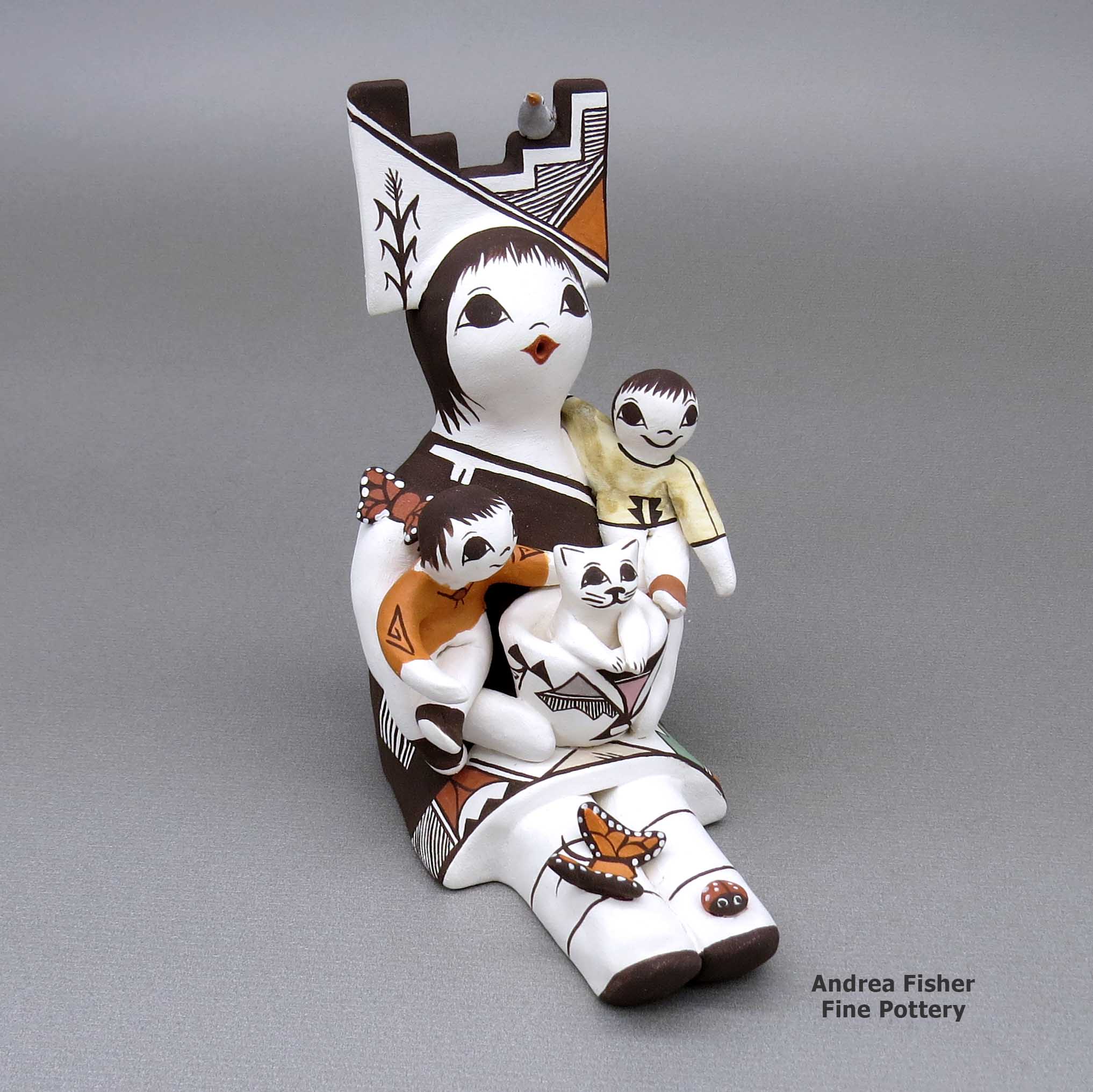
Judy Lewis, Acoma, Polychromestorytellerwithtwochildren,akitten,abowl,abird,twobutterflies,aladybug,andpaintedlizardandcornstalkdetails
Acoma
$ 375
zzac3m130m1
Polychrome storyteller with two children, a kitten, a bowl, a bird, two butterflies, a ladybug, and painted lizard and cornstalk details
4 in L by 2.5 in W by 4.75 in H
Condition: Excellent
Signature: Judy Lewis Acoma N.M.
Date Created: 2023
100 West San Francisco Street, Santa Fe, New Mexico 87501
(505) 986-1234 - www.andreafisherpottery.com - All Rights Reserved

Storytellers
Pueblos: Cochiti, Jemez, Acoma, Isleta, Santa Clara
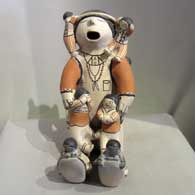
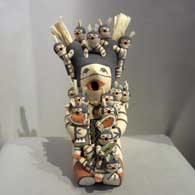

Historically, clay figures have been present in the Pueblo pottery tradition for most of the last thousand years. However, figures and effigies were denounced as "works of the devil" by the Spanish missionaries in New Mexico between 1540 and 1820. Before and after that time the art of making figurative sculpture flourished, especially at Cochiti Pueblo. The forms of animals, birds and caricatures of outsiders and, more recently, of images of mothers and grandfathers telling stories and singing to children have multiplied.
The "storyteller" is an important role in the tribe as parents are often too busy working and raising kids to pass on their tribal histories and the Native American people did not have a written language to record anything for posterity. The closest thing they had to a written language was pottery and the designs that decorated that pottery. So the storyteller's role was to preserve and retell and pass down the oral history of his people. In most tribes that role was fulfilled by men.
The first real storyteller figure was created in 1964 by Cochiti Pueblo potter Helen Cordero in memory of her grandfather, Santiago Quintana. She gathered her clay from a secret sacred place on the lands of her pueblo. Then she hand-coiled, hand painted and fired that first storyteller figure the traditional way: in the ground. Helen never used any molds or kilns to make her pottery.
Helen's creation struck a chord throughout all the pueblos as the storyteller is a figure central to all their societies. Most tribes also have the figure of the Singing Maiden in their pantheon and in many cases, the mix of Singing Maiden and Storyteller has blurred some lines in the pottery world. Today, as many as three hundred potters in thirteen pueblos have created storytellers, and their storytellers are not only men and women, but also Santa's, mudheads, koshares, bears, owls and other animals, sometimes encumbered with children numbering more than one hundred! Each potter has also customized their storyteller figures to more closely reflect the styles and dress of their own tribes, sometimes even of their own clans.
100 West San Francisco Street, Santa Fe, New Mexico 87501
(505) 986-1234 - www.andreafisherpottery.com - All Rights Reserved

Delores Sanchez Family Tree
Disclaimer: This "family tree" is a best effort on our part to determine who the potters are in this family and arrange them in a generational order. The general information available is questionable so we have tried to show each of these diagrams to living members of each family to get their input and approval, too. This diagram is subject to change should we get better info.
- Delores Sandoval Sanchez (ca. 1888-1991) & Toribio Sanchez
- Marie S. Juanico (1937-)
- Delores Aragon (Juanico) (1969-)
- Katherine Lewis (1932-)
- Bernard Lewis (1957-) & Sharon Lewis (1959-)
- Eric Lewis (1978-)
- Carolyn Concho (1961-)
- Alisha Sanchez & George Concho, Jr.
- Shaylene Chino
- Alisha Sanchez & George Concho, Jr.
- Diane Lewis (1959-)
- Judy Lewis (1966-)
- Rebecca Lucario(1951-)
- Amanda Lucario (1984-)
- Daniel Lucario (1969-)
- Marilyn Ray (1954-)
- Edward Lewis Jr. & Eva Concho
- Edward Lewis III
- Bernard Lewis (1957-) & Sharon Lewis (1959-)
- Ethel Shields (1926-) & Don Shields
- Charmae Shields Natseway (1958-) & Thomas Natseway (1953-)(Laguna)
- Chris Shields & Michelle Shields (1972-)
- Curtis Shields
- Isaac Shields
- Natasha Shields
- Jack Shields (c.1961-)
- Judy Shields (daughter-in-law)
- Verda Mae Shields (daughter-in-law)
Some of the above info is drawn from Southern Pueblo Pottery, 2000 Artist Biographies, by Gregory Schaaf, © 2002, Center for Indigenous Arts & Studies
Other info is derived from personal contacts with family members and through interminable searches of the Internet and cross-examination of the data found.
(505) 986-1234 - www.andreafisherpottery.com - All Rights Reserved


